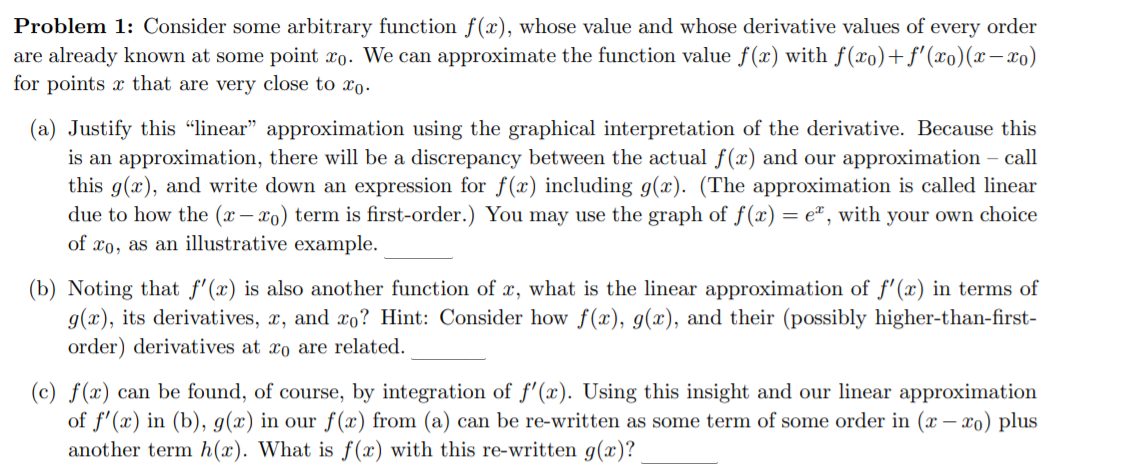Problem 1: Consider some arbitrary function f(x), whose value and whose derivative values of every order are already known at some point xo. We can approximate the function value f(x) with f(xo)+f'(xo)(x– xo) for points x that are very close to xo. (a) Justify this "linear" approximation using the graphical interpretation of the derivative. Because this is an approximation, there will be a discrepancy between the actual f(x) and our approximation – call this g(x), and write down an expression for f (x) including g(x). (The approximation is called linear due to how the (x– xo) term is first-order.) You may use the graph of f(x) = e², with your own choice of xo, as an illustrative example. (b) Noting that f'(x) is also another function of x, what is the linear approximation of f'(x) in terms of g(x), its derivatives, x, and xo? Hint: Consider how f(x), g(x), and their (possibly higher-than-first- order) derivatives at xo are related. (c) f(x) can be found, of course, by integration of f'(x). Using this insight and our linear approximation of f'(x) in (b), g(x) in our f(x) from (a) can be re-written as some term of some order in (x – xo) plus another term h(x). What is f(x) with this re-written g(x)?
Problem 1: Consider some arbitrary function f(x), whose value and whose derivative values of every order are already known at some point xo. We can approximate the function value f(x) with f(xo)+f'(xo)(x– xo) for points x that are very close to xo. (a) Justify this "linear" approximation using the graphical interpretation of the derivative. Because this is an approximation, there will be a discrepancy between the actual f(x) and our approximation – call this g(x), and write down an expression for f (x) including g(x). (The approximation is called linear due to how the (x– xo) term is first-order.) You may use the graph of f(x) = e², with your own choice of xo, as an illustrative example. (b) Noting that f'(x) is also another function of x, what is the linear approximation of f'(x) in terms of g(x), its derivatives, x, and xo? Hint: Consider how f(x), g(x), and their (possibly higher-than-first- order) derivatives at xo are related. (c) f(x) can be found, of course, by integration of f'(x). Using this insight and our linear approximation of f'(x) in (b), g(x) in our f(x) from (a) can be re-written as some term of some order in (x – xo) plus another term h(x). What is f(x) with this re-written g(x)?
Advanced Engineering Mathematics
10th Edition
ISBN:9780470458365
Author:Erwin Kreyszig
Publisher:Erwin Kreyszig
Chapter2: Second-order Linear Odes
Section: Chapter Questions
Problem 1RQ
Related questions
Question
100%
I am stuck on these problems. I would really appreciate if anyone can help me out.

Transcribed Image Text:Problem 1: Consider some arbitrary function f(x), whose value and whose derivative values of every order
are already known at some point xo. We can approximate the function value f(x) with f(xo)+f'(xo)(x-xo)
for points x that are very close to xo.
(a) Justify this "linear" approximation using the graphical interpretation of the derivative. Because this
is an approximation, there will be a discrepancy between the actual f(x) and our approximation – call
this g(x), and write down an expression for f (x) including g(x). (The approximation is called linear
due to how the (x – xo) term is first-order.) You may use the graph of f(x) = e" , with your own choice
of xo, as an illustrative example.
(b) Noting that f'(x) is also another function of x, what is the linear approximation of f'(x) in terms of
g(x), its derivatives, x, and xo? Hint: Consider how f(x), g(x), and their (possibly higher-than-first-
order) derivatives at xo are related.
(c) f(x) can be found, of course, by integration of f'(x). Using this insight and our linear approximation
of f'(x) in (b), g(x) in our f(x) from (a) can be re-written as some term of some order in (x – xo) plus
another term h(x). What is f(x) with this re-written g(x)?
Expert Solution
This question has been solved!
Explore an expertly crafted, step-by-step solution for a thorough understanding of key concepts.
Step by step
Solved in 3 steps with 3 images

Knowledge Booster
Learn more about
Need a deep-dive on the concept behind this application? Look no further. Learn more about this topic, advanced-math and related others by exploring similar questions and additional content below.Recommended textbooks for you

Advanced Engineering Mathematics
Advanced Math
ISBN:
9780470458365
Author:
Erwin Kreyszig
Publisher:
Wiley, John & Sons, Incorporated

Numerical Methods for Engineers
Advanced Math
ISBN:
9780073397924
Author:
Steven C. Chapra Dr., Raymond P. Canale
Publisher:
McGraw-Hill Education

Introductory Mathematics for Engineering Applicat…
Advanced Math
ISBN:
9781118141809
Author:
Nathan Klingbeil
Publisher:
WILEY

Advanced Engineering Mathematics
Advanced Math
ISBN:
9780470458365
Author:
Erwin Kreyszig
Publisher:
Wiley, John & Sons, Incorporated

Numerical Methods for Engineers
Advanced Math
ISBN:
9780073397924
Author:
Steven C. Chapra Dr., Raymond P. Canale
Publisher:
McGraw-Hill Education

Introductory Mathematics for Engineering Applicat…
Advanced Math
ISBN:
9781118141809
Author:
Nathan Klingbeil
Publisher:
WILEY

Mathematics For Machine Technology
Advanced Math
ISBN:
9781337798310
Author:
Peterson, John.
Publisher:
Cengage Learning,

